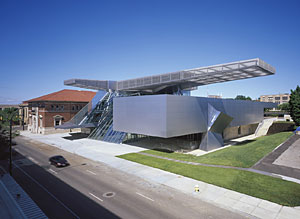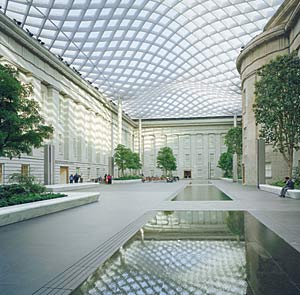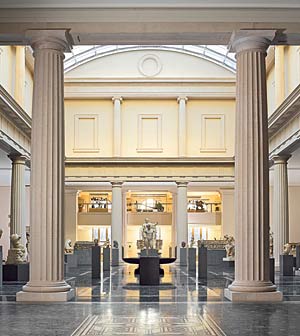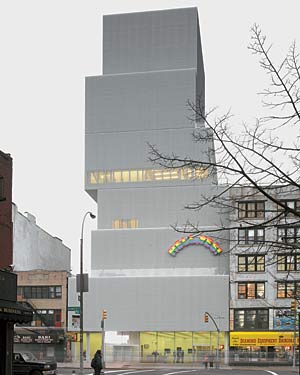

Let me be the first to declare my list of 2007’s highlights (and lowlights) of new museum architecture to be far from definitive. Certain obvious absences are not unintentional, however, particularly Steven Holl’s Bloch Building at the Nelson-Atkins Museum of Art in Kansas City, Missouri [RECORD, July 2007, page 92], which critics overwhelmingly praised. However, after I wrote two negative paragraphs about Holl’s Simmons Hall dormitory at MIT [RECORD, May 2003, page 204], he shot off an angry letter summoning me to his office for what he called “re-education,” a term I last heard during Mao Zedong’s Cultural Revolution as a euphemism for the persecution of intellectuals.
Naturally, I ignored Holl’s invitation, and knowing that the only thing architects hate more than a bad review is no review at all, I gave his Nelson-Atkins addition a pass. Certain drumbeat buildings demand every critic to weigh in, like it or not: Gehry’s Disney Concert Hall, Yoshio Taniguchi’s Museum of Modern Art (MoMA) expansion, and Daniel Libeskind’s Denver Art Museum wing come to mind. But beyond such rare media blowouts, skipping one museum or another nowadays seems less a sin of omission than necessary triage. Here, then, is my highly opinionated, wholly arbitrary, glaringly incomplete, and gleefully polarizing list of the best and worst new museums of the preceding calendar year, in ascending order from the ridiculous to the sublime.
John S. and James L. Knight Building, Akron Art Museum, by Coop Himmelb(l)au. Just as there are fashion victims whose gullible trendiness blinds them to how comical they appear, so there are architecture victims. Among the latest is the Akron Art Museum, now saddled with my nominee for architectural dud of the decade: the formally chaotic, haphazardly detailed, instantly dated-looking wing by Wolf Prix, of the annoyingly named Vienna firm Coop Himmelb(l)au. A leading exponent of Deconstructivism, Prix gave these misguided clients the gee-willikers conversation piece they wanted. But far from being the next Bilbao, this provincial embarrassment offers graphic evidence of the contemporary museum world’s inverted priorities. The Akron addition’s strenuously flamboyant yet oddly inhospitable public spaces lead to some of the dullest, least imaginative exhibition galleries I’ve seen lately, making this my suggested first stop on a how-not-to-do-it tour for museum building committees.
Creation Museum, Petersburg, Kentucky, by A.M. Kinney Associates. At a time when museums are accused of turning themselves into theme parks, along comes a bizarre new institution that makes Walt Disney World seem like the Albertina. This is not surprising, since the displays of cartoonish dinosaurs and humanoids at the Creation Museum—devised to supplant Darwin’s theory of evolution with a Bible-based fantasia of the world’s origins—were dreamed up by a former Universal Studios designer, Patrick Marsh. I use the term “institution” in both the museological and the psychiatric sense, because this only-in-America loony bin is no more a museum than I am Napoleon. Even more unsettling than its mission to enlist impressionable children in the Christian fundamentalist crusade against scientific reason is the fact that there are already two dozen such creationist museums around the country, though none equals this in impressive presentation values that make it all the more pernicious. In flat-out rejection of the Enlightenment rationalism that brought the United States into being, the Creation Museum is more frightening than Disney’s Haunted Mansion. Let us pray.
Kogod Courtyard, Smithsonian American Art Museum and National Portrait Gallery, Washington, D.C., by Foster + Partners. There’s no denying the technical expertise and faultless execution guaranteed by Norman Foster’s London-based firm. But it started one of the most pointless fads in recent museum architecture with the glass-roofed Queen Elizabeth II Great Court at London’s British Museum [RECORD, March, 2001, page 114]. There’s something deeply weird about that space, bathed in a surreal glow that makes everything and everyone beneath the diamond-latticed canopy seem fake. Yes, London was the site of the seminal Crystal Palace, wellspring of high-tech design and granddaddy of all shopping malls. But the growing compulsion to glaze over museum courtyards everywhere smacks of suburban commercialization.


The D.C. variation on the London theme features graceful undulations, but one’s ultimate response is “So what?” Given the financial and organizational problems plaguing the embattled Smithsonian system, it’s a shame that the largesse of patriotic donors wasn’t applied to something more urgent than a gratuitous display of engineering virtuosity, which adds nothing of value to these two underappreciated institutions.
Greek and Roman Galleries, Metropolitan Museum of Art, New York City, by Jeffrey Daly after a master plan by Kevin Roche John Dinkeloo Associates. Although neither freestanding addition nor autonomous wing, the Met’s new Greek and Roman Galleries, sun-flooded and majestic, merit a high place among recent museum successes. The idea for converting the Met’s erstwhile cafeteria (dubbed the “Dorotheum” after its chi-chi 1954 makeover by decorator Dorothy Draper) into gallery space for Classical antiquities grew from the master plan of Kevin Roche, but design credit belongs to the museum’s Jeffrey Daly, with considerable help from Greek and Roman curator Carlos Picón and colleagues. Machado and Silvetti Associates’ shrewdly unironic recasting of the Roman replica Getty Villa in Malibu [RECORD, May 2006, page 106] took the high-style curse off historical revivalism and legitimized the unapologetic traditionalism of the Met’s latest museum-within-a-museum: the final triumph of Philippe de Montebello’s long, glorious, and lamentably concluding directorship.
Museum of Contemporary Art, Denver, by Adjaye Associates. Though only 42, London-based David Adjaye has swiftly become a fixture on today’s hippest architectural short lists, including the New Museum commission, ultimately won by SANAA. His invigorating design for its Denver counterpart confirms him as a leader among the profession’s mid-career generation. After Libeskind’s sculpturally overwrought, functionally troubled, titanium-plated Denver Art Museum addition [RECORD, January, 2007, page 84], this elegant, Minimalist box, clad in smoky tinted glass, seems the antithesis of passé post-Bilbao “destination” architecture. Although Adjaye’s flexible series of display spaces has struck some as insufficiently defined, I’ll take his adaptable amorphousness over Libeskind’s Cinderella-slipper formalism any day.
Perelman Building, Philadelphia Museum of Art, by Gluckman Mayner Architects. Because Richard Gluckman made his bones converting gritty industrial relics into peerless exhibition spaces, I had qualms about his turning a fancy Classical Deco office building into a contemporary art annex. Not to worry. The Perelman feels absolutely right from start to finish, providing protective, internalized rooms for light-sensitive photography, costume, and design, but also an airy, loftlike gallery that makes sculpture and installation pieces look terrific. Neither unduly deferential nor anyway disrespectful toward the landmark original, Gluckman and David Mayner again prove how their inspired retrofits trump most of today’s start-from-scratch museum schemes.
Museo del Prado addition, Madrid, by Jose Rafael Moneo Arquitecto. An almost audible sigh of relief wafted through the art world when Rafael Moneo’s Prado wing was inaugurated last October. Although Moneo designed the imposing National Museum of Roman Art, in Mérida, Spain (1986), for the Prado he rejected any hint of grandiosity and crafted an appropriately dignified amplificación that neither plays possum nor begs for attention. This stolid brick treasure chest pays subtle homage to the foursquare masonry of traditional Spanish architecture, and graciously focuses on the 19th-century art inside. With consummate self-assurance, Moneo, an underrated master, elevates himself high above the fray of today’s sensation-seeking museum mongers.
New Museum for Contemporary Art, New York City, by SANAA. My choice for 2007’s Museum of the Year. All right, it’s not perfect, but despite industrial-strength fluorescent-tube lighting, narrow stairways, and a few other lapses, no new museum in recent memory has exhilarated me nearly as much as this haunting, Minimalist icon. Kazuyo Sejima and Ryue Nishizawa’s astonishing triumph over a tight budget and even more restricted site is no less than an urbanistic tour-de-force.
This Miracle on the Bowery, as I’ve called it, delivers spaces hospitable to contemporary art of all kinds, as well as a stunning refutation of the spurious grow-or-die philosophy epitomized by MoMA’s soul-killing metamorphosis from schmoozy art-world hangout to global corporate headquarters. The svelte New Museum cost $50 million; the steroidal new MoMA, more than $500 million. Museum boards take note: You sometimes get what you don’t pay for.


Post a comment to this article
Report Abusive Comment